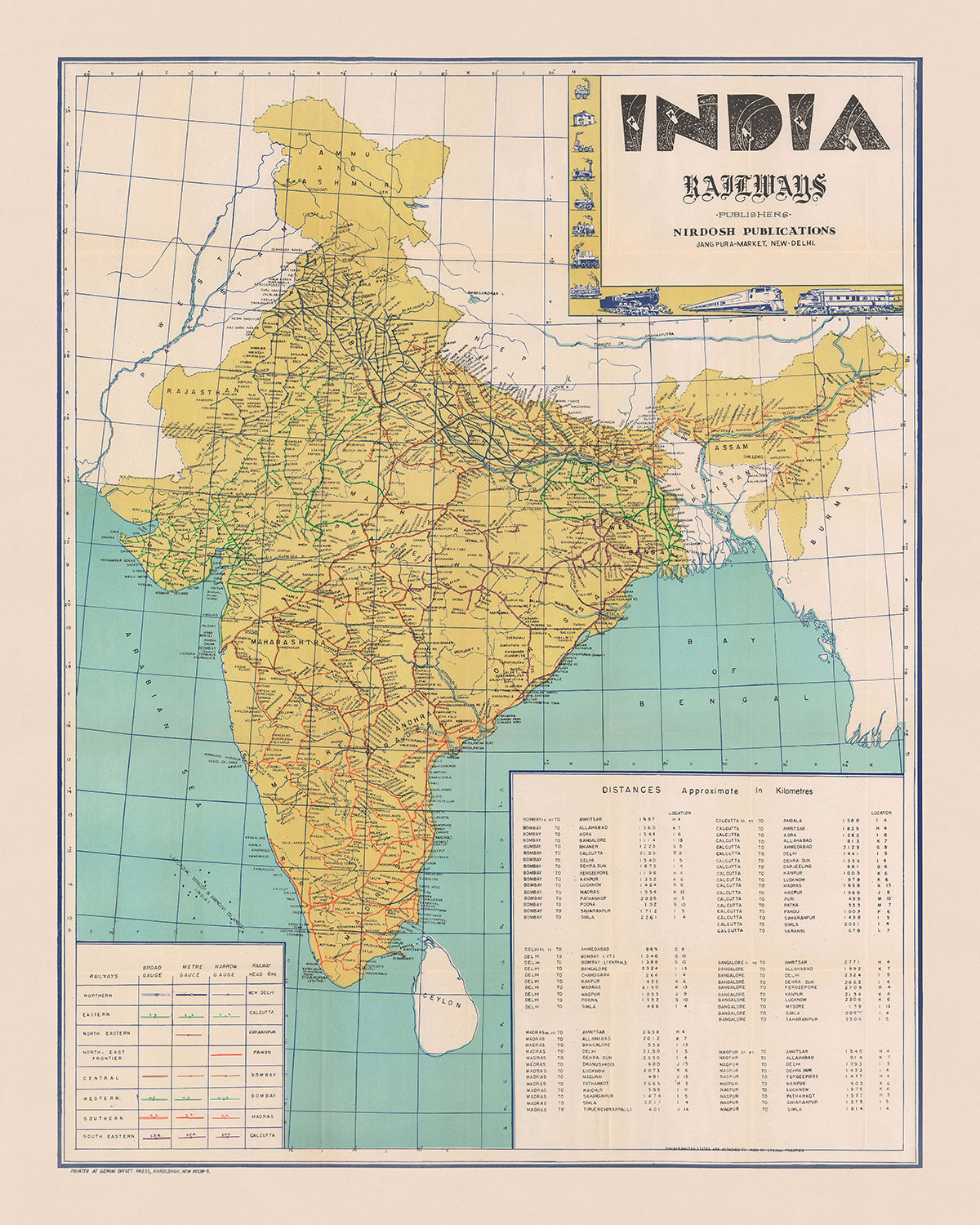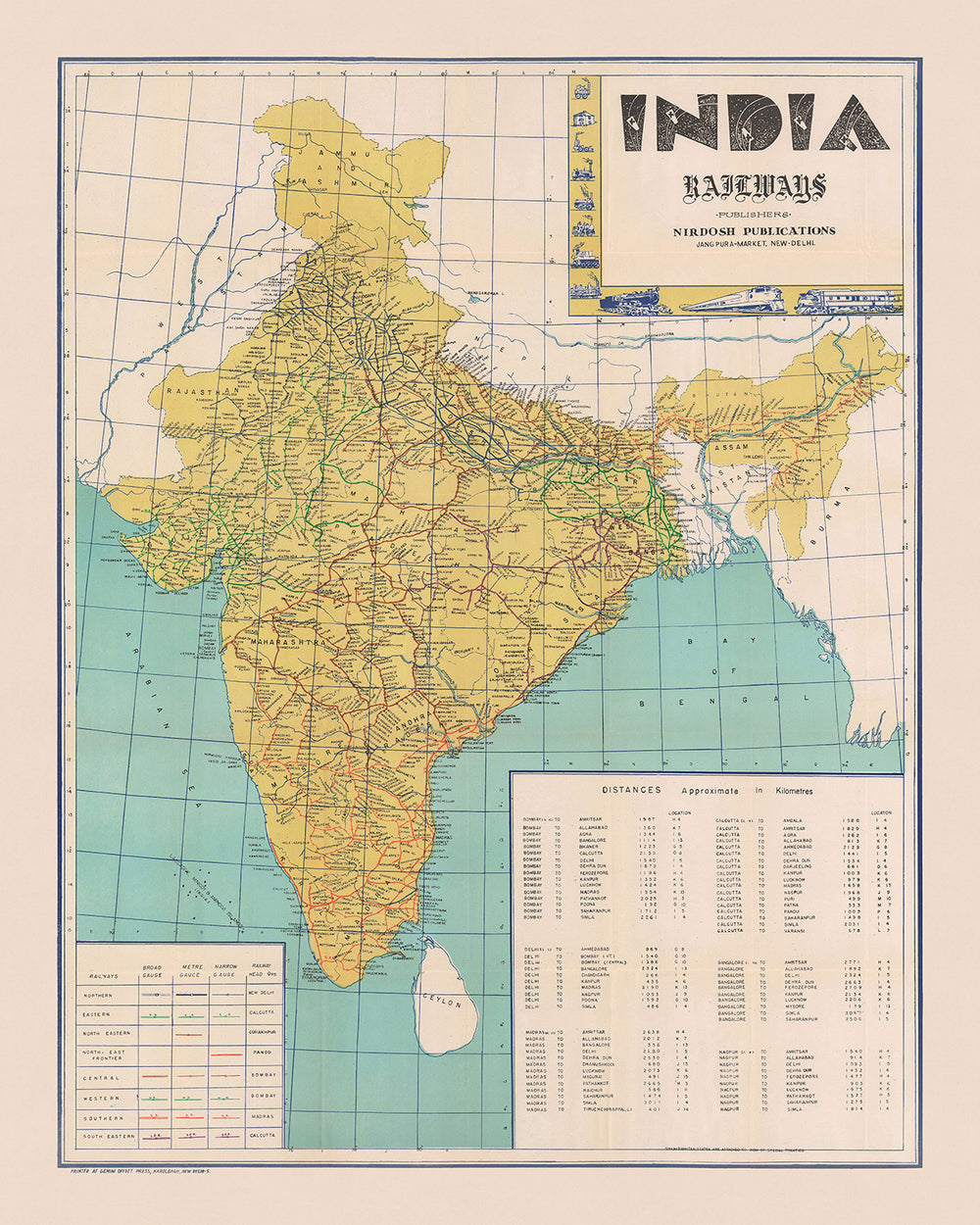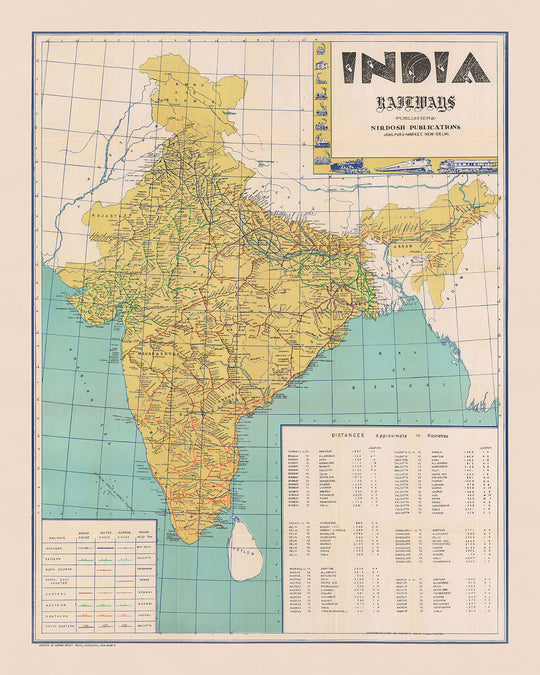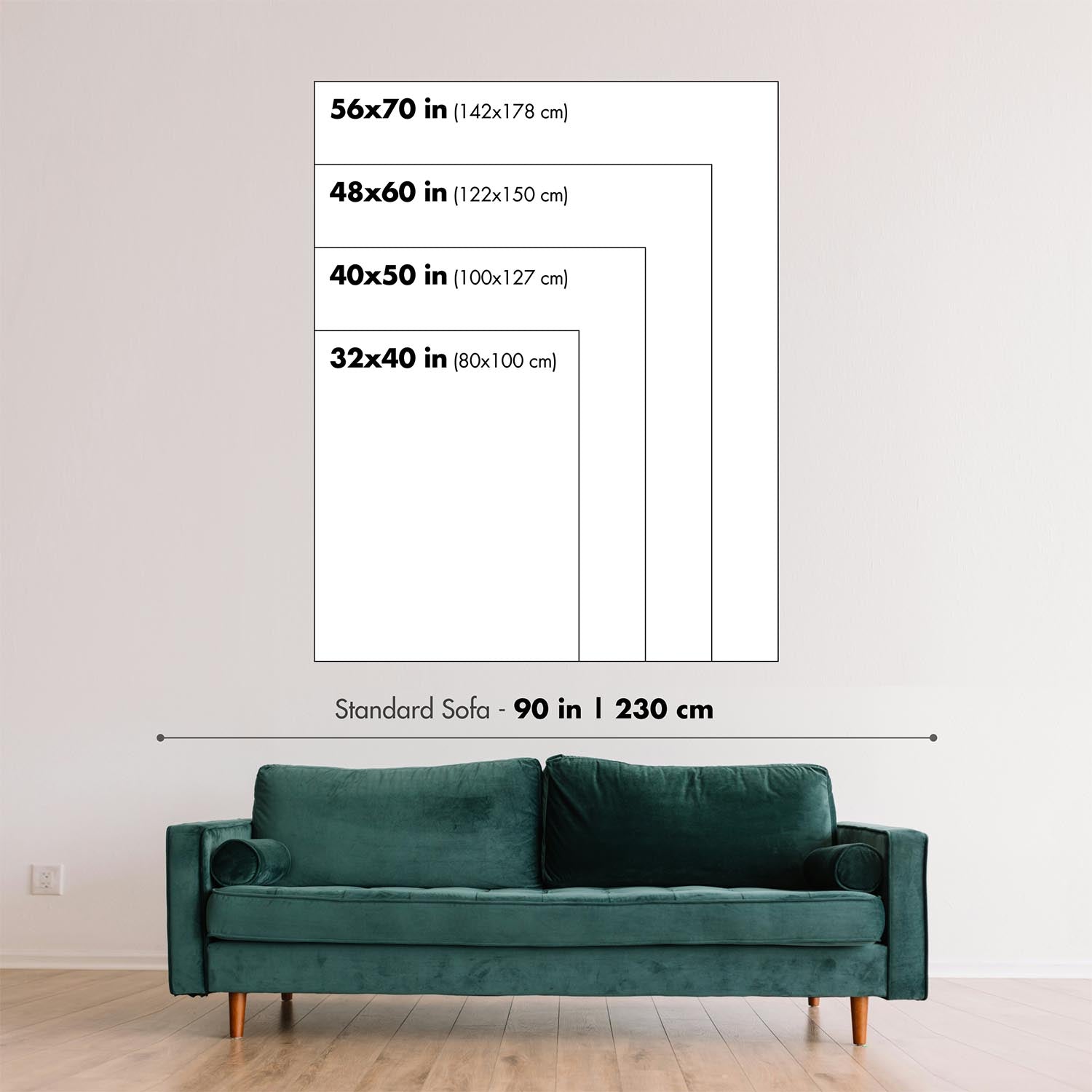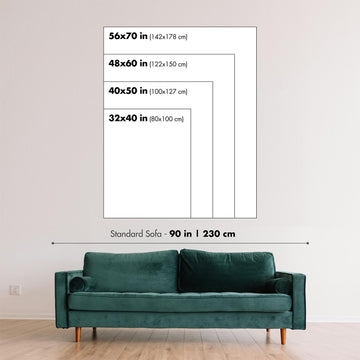- Handmade locally. No import duty or tax
- FREE worldwide delivery
- Love it or your money back (90 days)
- Questions? WhatsApp me any time
Own a piece of history
5,000+ 5 star reviews


Presenting the "India Railways" map, an exquisite cartographic masterpiece created by Nirdosh Publications in 1960. This thematic map is a detailed portrayal of India's extensive railway network, meticulously differentiated by color and track gauge. Each railway line is vividly illustrated, showcasing the routes of the Eastern, Western, Southern, and Southeastern Railways. This map is not just a navigational tool but a historical document that captures the essence of India's post-independence transportation infrastructure, reflecting the nation's efforts to connect its diverse regions through a robust railway system.
Nirdosh Publications, the esteemed mapmaker behind this creation, has a legacy of producing high-quality cartographic works. Printed by the Gemini Offset Press in New Delhi, this map exemplifies the precision and artistry of mid-20th-century Indian cartography. The decorative title cartouche, adorned with vignettes of historical train engines, adds a touch of elegance and nostalgia, making it a perfect blend of functionality and aesthetic appeal. The map's design and execution are a testament to the skill and dedication of its creators, who aimed to provide a comprehensive and visually appealing representation of India's railways.
The map's detailed depiction of cities and towns along every railway line offers a fascinating glimpse into India's urban landscape during the 1960s. Major cities like Mumbai, Delhi, Kolkata, and Chennai are prominently featured, along with numerous smaller towns that played crucial roles in the country's economic and social fabric. The inclusion of a table providing distances between major cities in kilometers enhances the map's utility, making it an invaluable resource for travelers and historians alike. This feature underscores the map's practical significance, offering insights into the connectivity and accessibility of various regions.
Geographical features such as the Bay of Bengal and the Arabian Sea are labeled, providing context to the railway routes that traverse the subcontinent. The general representation of the Himalayas in the northern region adds a layer of geographical context, highlighting the challenges and triumphs of constructing railways in diverse terrains. The map's focus on railways, while omitting other political and geographical features, emphasizes the importance of rail transport in unifying the nation and facilitating trade, travel, and communication.
Historically, the "India Railways" map is a valuable artifact that reflects the state of India's railway network in the post-independence era. It captures a pivotal moment in the nation's history when railways were a symbol of progress and modernization. The map not only serves as a navigational aid but also as a historical document that offers insights into the development of India's transportation infrastructure. It stands as a testament to the vision and ambition of a nation striving to connect its people and regions through an intricate web of railways.
Cities and towns on this map
- India:
- Mumbai
- Delhi
- Kolkata
- Chennai
- Bangalore
- Hyderabad
- Ahmedabad
- Pune
- Surat
- Kanpur
- Jaipur
- Lucknow
- Nagpur
- Indore
- Bhopal
- Patna
- Vadodara
- Ghaziabad
- Ludhiana
- Agra
- Nashik
- Faridabad
- Meerut
- Rajkot
- Kalyan-Dombivli
- Vasai-Virar
- Varanasi
- Srinagar
- Aurangabad
- Dhanbad
- Amritsar
- Navi Mumbai
- Allahabad
- Ranchi
- Howrah
- Coimbatore
- Jabalpur
- Gwalior
- Vijayawada
- Jodhpur
- Madurai
- Raipur
- Kota
- Guwahati
- Chandigarh
- Solapur
- Hubballi-Dharwad
- Tiruchirappalli
- Bareilly
- Aligarh
- Tiruppur
- Moradabad
- Mysore
- Gurgaon
- Alwar
- Jalandhar
- Bhubaneswar
- Salem
- Mira-Bhayandar
- Thiruvananthapuram
- Bhiwandi
- Saharanpur
- Gorakhpur
- Guntur
- Bikaner
- Noida
- Jamshedpur
- Bhavnagar
- Cuttack
- Firozabad
- Kochi
- Bhilai
- Amravati
- Kolhapur
- Ulhasnagar
- Ajmer
- Gulbarga
- Jamnagar
- Ujjain
- Loni
- Siliguri
- Jhansi
- Uluberia
- Nellore
- Jammu
- Sangli-Miraj & Kupwad
- Belgaum
- Mangalore
- Ambattur
- Tirunelveli
- Malegaon
- Gaya
- Jalgaon
- Udaipur
- Maheshtala
- Durgapur
- Bellary
- Muzaffarnagar
- Kurnool
- Bharatpur
- Shahjahanpur
- Avadi
- Kadapa
- Nanded
- Panihati
- Sambalpur
- Bilaspur
- Shimoga
- Tumkur
- Karimnagar
- Gopalpur
- Dehradun
- Gandhinagar
- Thanjavur
- Katihar
- Dibrugarh
- Silchar
- Imphal
- Aizawl
- Kohima
- Itanagar
- Port Blair
Notable Features & Landmarks
- Inset maps:
- None visible.
- Illustrations:
- Vignettes of historical train engines in the upper right corner.
- Landmarks:
- None specifically labeled.
- Bodies of water:
- Bay of Bengal
- Arabian Sea
- Borders:
- International borders of India
- Border with Ceylon (modern-day Sri Lanka)
- Mountains:
- General representation of the Himalayas in the northern region.
- Other notable features:
- Table of distances between major cities in kilometers in the lower right.
- Key explaining railway notations in the lower left.
Historical and design context
- Name of the map: India Railways
- Extra notes:
- This is a c. 1960 railroad map of India.
- Depicts India's railroad network in detail.
- Eight different railways are differentiated by color and further divided by track gauge.
- Routes of the Eastern Railway, Western Railway, Southern Railway, and Southeastern Railway are labeled.
- Cities and towns are labeled along every line.
- A table providing distances between major cities in kilometers is located in the lower right.
- A key in the lower left explains notations used to differentiate railways and broad-, meter-, and narrow-gauge lines.
- A decorative title cartouche appears in the upper right bordered by vignettes of historical train engines.
- When the map was made: 1960
- Mapmaker or publisher: Nirdosh Publications
- Printed by the Gemini Offset Press in New Delhi.
- Topics and themes shown on the map:
- Primarily a railway map.
- Differentiates between broad-, meter-, and narrow-gauge lines.
- Highlights the extensive railroad network in India during the 1960s.
- Countries and regions shown on the map: India, with a portion of Ceylon (modern-day Sri Lanka).
- Design or style of the map:
- Thematic map focusing on railroads.
- Uses color coding to differentiate between various railways and track gauges.
- Includes decorative elements such as vignettes of historical train engines.
- Historical significance or context:
- Reflects the state of India's railway network in the post-independence era.
- Illustrates the importance of railways in connecting various parts of India.
- Provides historical insight into transportation and infrastructure development during the 1960s.
Please double check the images to make sure that a specific town or place is shown on this map. You can also get in touch and ask us to check the map for you.
This map looks great at every size, but I always recommend going for a larger size if you have space. That way you can easily make out all of the details.
This map looks amazing at sizes all the way up to 50in (125cm). If you are looking for a larger map, please get in touch.
Please note: the labels on this map are hard to read if you order a map that is 16in (40cm) or smaller. The map is still very attractive, but if you would like to read the map easily, please buy a larger size.
The model in the listing images is holding the 16x20in (40x50cm) version of this map.
The fifth listing image shows an example of my map personalisation service.
If you’re looking for something slightly different, check out my collection of the best old maps to see if something else catches your eye.
Please contact me to check if a certain location, landmark or feature is shown on this map.
This would make a wonderful birthday, Christmas, Father's Day, work leaving, anniversary or housewarming gift for someone from the areas covered by this map.
This map is available as a giclée print on acid free archival matte paper, or you can buy it framed. The frame is a nice, simple black frame that suits most aesthetics. Please get in touch if you'd like a different frame colour or material. My frames are glazed with super-clear museum-grade acrylic (perspex/acrylite), which is significantly less reflective than glass, safer, and will always arrive in perfect condition.
This map is also available as a float framed canvas, sometimes known as a shadow gap framed canvas or canvas floater. The map is printed on artist's cotton canvas and then stretched over a handmade box frame. We then "float" the canvas inside a wooden frame, which is available in a range of colours (black, dark brown, oak, antique gold and white). This is a wonderful way to present a map without glazing in front. See some examples of float framed canvas maps and explore the differences between my different finishes.
For something truly unique, this map is also available in "Unique 3D", our trademarked process that dramatically transforms the map so that it has a wonderful sense of depth. We combine the original map with detailed topography and elevation data, so that mountains and the terrain really "pop". For more info and examples of 3D maps, check my Unique 3D page.
For most orders, delivery time is about 3 working days. Personalised and customised products take longer, as I have to do the personalisation and send it to you for approval, which usually takes 1 or 2 days.
Please note that very large framed orders usually take longer to make and deliver.
If you need your order to arrive by a certain date, please contact me before you order so that we can find the best way of making sure you get your order in time.
I print and frame maps and artwork in 23 countries around the world. This means your order will be made locally, which cuts down on delivery time and ensures that it won't be damaged during delivery. You'll never pay customs or import duty, and we'll put less CO2 into the air.
All of my maps and art prints are well packaged and sent in a rugged tube if unframed, or surrounded by foam if framed.
I try to send out all orders within 1 or 2 days of receiving your order, though some products (like face masks, mugs and tote bags) can take longer to make.
If you select Express Delivery at checkout your order we will prioritise your order and send it out by 1-day courier (Fedex, DHL, UPS, Parcelforce).
Next Day delivery is also available in some countries (US, UK, Singapore, UAE) but please try to order early in the day so that we can get it sent out on time.
My standard frame is a gallery style black ash hardwood frame. It is simple and quite modern looking. My standard frame is around 20mm (0.8in) wide.
I use super-clear acrylic (perspex/acrylite) for the frame glass. It's lighter and safer than glass - and it looks better, as the reflectivity is lower.
Six standard frame colours are available for free (black, dark brown, dark grey, oak, white and antique gold). Custom framing and mounting/matting is available if you're looking for something else.
Most maps, art and illustrations are also available as a framed canvas. We use matte (not shiny) cotton canvas, stretch it over a sustainably sourced box wood frame, and then 'float' the piece within a wood frame. The end result is quite beautiful, and there's no glazing to get in the way.
All frames are provided "ready to hang", with either a string or brackets on the back. Very large frames will have heavy duty hanging plates and/or a mounting baton. If you have any questions, please get in touch.
See some examples of my framed maps and framed canvas maps.
Alternatively, I can also supply old maps and artwork on canvas, foam board, cotton rag and other materials.
If you want to frame your map or artwork yourself, please read my size guide first.
My maps are extremely high quality reproductions of original maps.
I source original, rare maps from libraries, auction houses and private collections around the world, restore them at my London workshop, and then use specialist giclée inks and printers to create beautiful maps that look even better than the original.
My maps are printed on acid-free archival matte (not glossy) paper that feels very high quality and almost like card. In technical terms the paper weight/thickness is 10mil/200gsm. It's perfect for framing.
I print with Epson ultrachrome giclée UV fade resistant pigment inks - some of the best inks you can find.
I can also make maps on canvas, cotton rag and other exotic materials.
Learn more about The Unique Maps Co.
Map personalisation
If you're looking for the perfect anniversary or housewarming gift, I can personalise your map to make it truly unique. For example, I can add a short message, or highlight an important location, or add your family's coat of arms.
The options are almost infinite. Please see my map personalisation page for some wonderful examples of what's possible.
To order a personalised map, select "personalise your map" before adding it to your basket.
Get in touch if you're looking for more complex customisations and personalisations.
Map ageing
I have been asked hundreds of times over the years by customers if they could buy a map that looks even older.
Well, now you can, by selecting Aged before you add a map to your basket.
All the product photos you see on this page show the map in its Original form. This is what the map looks like today.
If you select Aged, I will age your map by hand, using a special and unique process developed through years of studying old maps, talking to researchers to understand the chemistry of aging paper, and of course... lots of practice!
If you're unsure, stick to the Original colour of the map. If you want something a bit darker and older looking, go for Aged.
If you are not happy with your order for any reason, contact me and I'll get it fixed ASAP, free of charge. Please see my returns and refund policy for more information.
I am very confident you will like your restored map or art print. I have been doing this since 1984. I'm a 5-star Etsy seller. I have sold tens of thousands of maps and art prints and have over 5,000 real 5-star reviews. My work has been featured in interior design magazines, on the BBC, and on the walls of dozens of 5-star hotels.
I use a unique process to restore maps and artwork that is massively time consuming and labour intensive. Hunting down the original maps and illustrations can take months. I use state of the art and eye-wateringly expensive technology to scan and restore them. As a result, I guarantee my maps and art prints are a cut above the rest. I stand by my products and will always make sure you're 100% happy with what you receive.
Almost all of my maps and art prints look amazing at large sizes (200cm, 6.5ft+) and I can frame and deliver them to you as well, via special oversized courier. Contact me to discuss your specific needs.
Or try searching for something!







